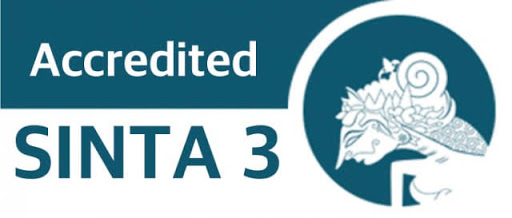Development of test instruments to measure high level thinking ability of two linear variable equations system
DOI:
https://doi.org/10.12928/ijei.v1i2.3540Keywords:
higher order thinking, systems of linear equations, testsAbstract
This study aims to develop a test instrument to measure the high-level thinking ability of the two-variable linear equation system material. This research is a Research and Development using the ADDIE development model consisting of steps of analysis, design, development, implementation, and evaluation. The test subjects in this study were students of class VIII of SMP Negeri 3 Payung. The instruments used in this study were validation sheets and documentation. Data collection techniques through expert judgment and tests. This research has succeeded in developing a test instrument to measure the high-level thinking ability of two-variable linear equations system material. The test developed consists of 10 multiple choice items and 5 description items that have been declared valid by expert judgment. The trial results show from the difficulty index analysis of multiple-choice questions was obtained as much as 1 item in the easy category, 9 questions in the moderate category, the analysis of the difficulty index for the essay obtained by 2 items in the medium category, 3 questions in the difficult category. In the analysis of discriminant index of multiple-choice questions, there were 1 question in the bad category, 3 questions with enough categories, and 6 questions in the good category. In the analysis of the difference in power, 2 questions were categorized as bad, 1 question was categorized as sufficient, 2 questions were categorized as good. Based on the analysis of the function of the distractor, it was found that 1 question was not functioning properly, 9 questions were functioning properly. Finally, from the reliability analysis, it was obtained 0.73 for multiple choice questions and 0.716 for essay questions with high reliability interpretation.
References
Barak, M., & Dori, Y. J. (2009). Enhancing higher order thinking skills among interface science teachers via embedded assessment. Journal of Science Teacher Education, 20(5), 459-474.
Branch, R. M. (2009). Instructional Design: The ADDIE Approach. New York: Springer.
Dori, Y. J., & Belcher, J. W. (2005). How does technology-enabled active learning affect students' understanding of scientific concepts? The Journal of the Learning Sciences, 14, 243-279.
Iskandar, A., & Rizal, M. (2018). Analisis kualitas soal di perguruan tinggi berbasis aplikasi TAP. Jurnal Penelitian dan Evaluasi Pendidikan, 22(1), 12-23.
Ivie, S. D. (1998). Ausubel’s learning theory: An approach to teaching higher order thinking skills. The High School Journal, 82(1), 35-42.
Lewis, A., & Smith, D. (1993). Defining Higher Order Thinking. Theory Into Practice, 32(3), 131-137.
Martina. (2017). Pengembangan instrumen tes higher order thinking skill (HOTS) pokok bahasan sistem persamaan linear dua variabel dan teorema Pythagoras kelas VIII SMP Citra Samata Kab. Gowa. Skripsi. Makassar: Universitas Islam Negeri Alauddin Makassar.
MOEC. (2016a). Permendikbud Nomor 58 Tahun 2016 Tentang Rincian Tugas Unit Kerja Di Lingkungan Lembaga Pengembangan Dan Pemberdayaan Pendidik Dan Tenaga Kependidikan Bidang Kelautan, Perikanan, Teknologi Informasi Dan Komunikasi. Jakarta: Ministry of Education and Culture.
MOEC. (2016b). Peraturan Menteri Pendidikan dan Kebudayaan RI Nomor 21 Tahun 2016 tentang Standar Isi Jenjang Pendidikan Dasar dan Menengah. Jakarta: Ministry of Education and Culture.
Saputra, H. (2016). Pengembangan Mutu Pendidikan Menuju Era Global: Penguatan Mutu Pembelajaran dengan Penerapan HOTS (High Order Thinking Skills). Bandung: SMILE’s Publishing.
Scully, D. (2017). Constructing multiple-choice items to measure higher-order thinking. Practical Assessment, Research & Evaluation, 22(4), 1-13.
Tobin, K., Kahle, J., & Fraser, B. (1990). Windows into science classrooms: Problems associated with higher-level cognitive learning. London: Falmer.
Young, A. (1997). Higher-order learning and thinking: What is it and how is it taught? Educational Technology, 37(4), 38–41.
Downloads
Published
Issue
Section
License
Authors who publish with this journal agree to the following terms:
- Authors retain copyright with the work simultaneously licensed under a Creative Commons Attribution License that allows others to share the work with an acknowledgement of the work's authorship and initial publication in this journal.
- Authors are able to enter into separate, additional contractual arrangements for the non-exclusive distribution of the journal's published version of the work (e.g., post it to an institutional repository or publish it in a book), with an acknowledgement of its initial publication in this journal.
- Authors are permitted and encouraged to post their work online (e.g., in institutional repositories or on their website) prior to and during the submission process, as it can lead to productive exchanges, as well as earlier and greater citation of published work (See The Effect of Open Access).




